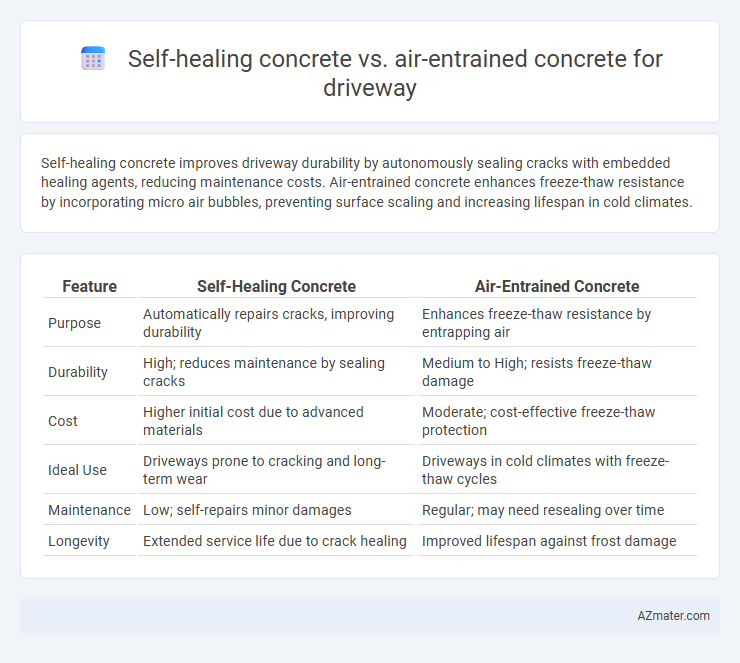Self-healing concrete improves driveway durability by autonomously sealing cracks with embedded healing agents, reducing maintenance costs. Air-entrained concrete enhances freeze-thaw resistance by incorporating micro air bubbles, preventing surface scaling and increasing lifespan in cold climates.
Table of Comparison
| Feature | Self-Healing Concrete | Air-Entrained Concrete |
|---|---|---|
| Purpose | Automatically repairs cracks, improving durability | Enhances freeze-thaw resistance by entrapping air |
| Durability | High; reduces maintenance by sealing cracks | Medium to High; resists freeze-thaw damage |
| Cost | Higher initial cost due to advanced materials | Moderate; cost-effective freeze-thaw protection |
| Ideal Use | Driveways prone to cracking and long-term wear | Driveways in cold climates with freeze-thaw cycles |
| Maintenance | Low; self-repairs minor damages | Regular; may need resealing over time |
| Longevity | Extended service life due to crack healing | Improved lifespan against frost damage |
Introduction to Modern Concrete Technologies
Self-healing concrete utilizes advanced microcapsules or bacteria to autonomously repair cracks, enhancing driveway durability and reducing maintenance costs. Air-entrained concrete improves freeze-thaw resistance by incorporating microscopic air bubbles, preventing surface scaling and prolonging pavement lifespan in cold climates. Both modern concrete technologies significantly improve driveway performance by addressing durability challenges through innovative material science.
Understanding Self-Healing Concrete
Self-healing concrete incorporates advanced microcapsules or bacteria that activate upon crack formation, automatically repairing damage and enhancing durability. Unlike air-entrained concrete, which relies on microscopic air bubbles to improve frost resistance, self-healing concrete actively extends the lifespan of driveways by reducing maintenance needs and preventing structural deterioration. This innovative material offers a sustainable solution for maintaining driveway integrity in diverse weather conditions.
Overview of Air-Entrained Concrete
Air-entrained concrete contains microscopic air bubbles that improve durability and resistance to freeze-thaw cycles, making it ideal for driveways in cold climates. The air entrainment reduces cracking and scaling by providing space for water to expand when it freezes. While self-healing concrete actively repairs cracks through embedded healing agents, air-entrained concrete offers enhanced structural longevity by preventing damage from environmental stressors.
Key Features and Mechanisms
Self-healing concrete incorporates microcapsules or bacteria that activate upon cracking, releasing healing agents to autonomously repair damage and extend driveway lifespan. Air-entrained concrete contains microscopic air bubbles introduced during mixing, enhancing freeze-thaw durability by providing space for water expansion and reducing cracking risks in colder climates. Both technologies improve driveway longevity, but self-healing concrete actively repairs micro-cracks, while air-entrained concrete passively prevents damage from ice formation.
Durability and Longevity Comparison
Self-healing concrete incorporates microcapsules or bacteria that activate upon cracking, significantly enhancing durability by autonomously sealing microcracks and preventing water ingress, which extends the driveway's lifespan. Air-entrained concrete improves freeze-thaw resistance by trapping microscopic air bubbles, reducing internal pressure and mitigating surface scaling, but it does not repair existing damage. For long-term longevity, self-healing concrete offers superior crack remediation and structural integrity, while air-entrained concrete provides effective protection against environmental stressors without self-repair capabilities.
Resistance to Freeze-Thaw Cycles
Self-healing concrete enhances resistance to freeze-thaw cycles by autonomously repairing microcracks, preventing water ingress and reducing structural damage over time. Air-entrained concrete improves freeze-thaw durability by incorporating microscopic air bubbles that relieve internal pressure from expanding ice, thus minimizing cracking and scaling. For driveways exposed to harsh winter conditions, self-healing concrete offers long-term maintenance benefits, while air-entrained concrete provides effective freeze-thaw protection through established entrainment technology.
Maintenance and Repair Needs
Self-healing concrete significantly reduces maintenance and repair needs for driveways by autonomously sealing cracks through embedded healing agents, minimizing water infiltration and freeze-thaw damage. In contrast, air-entrained concrete, designed to improve freeze-thaw resistance by incorporating microscopic air bubbles, requires routine maintenance to address surface wear and prevent deeper cracking. Choosing self-healing concrete offers long-term durability advantages and lower repair costs compared to air-entrained concrete, which primarily enhances immediate freeze-thaw resilience.
Cost Analysis and Economic Considerations
Self-healing concrete offers long-term cost savings by reducing maintenance and repair expenses due to its ability to autonomously repair cracks, which is beneficial for driveways exposed to weathering and heavy loads. Air-entrained concrete provides better freeze-thaw durability at a lower initial cost but may require more frequent repairs over time, increasing lifecycle costs. Evaluating the total cost of ownership, self-healing concrete presents a higher upfront investment but superior economic value through extended durability and reduced repair frequency.
Environmental Impact and Sustainability
Self-healing concrete reduces environmental impact by extending the driveway's lifespan and minimizing the need for repairs and resource consumption, using bacteria or chemical agents to autonomously repair cracks. Air-entrained concrete enhances durability against freeze-thaw cycles by incorporating microscopic air bubbles, reducing deterioration in climates with harsh winters but often requires higher cement content, leading to increased carbon emissions. Choosing self-healing concrete supports sustainability better by lowering long-term carbon footprint and maintenance needs compared to air-entrained concrete's initial performance benefits in cold environments.
Choosing the Best Concrete for Driveways
Self-healing concrete offers enhanced durability by automatically repairing cracks through embedded microcapsules or bacteria, reducing maintenance costs and extending driveway lifespan. Air-entrained concrete improves freeze-thaw resistance by incorporating microscopic air bubbles, making it ideal for colder climates prone to frequent temperature fluctuations. Choosing the best concrete depends on environmental conditions and long-term maintenance goals, with self-healing concrete suited for crack-prone areas and air-entrained concrete preferred in regions facing severe winter weather.

Infographic: Self-healing concrete vs Air-entrained concrete for Driveway
 azmater.com
azmater.com